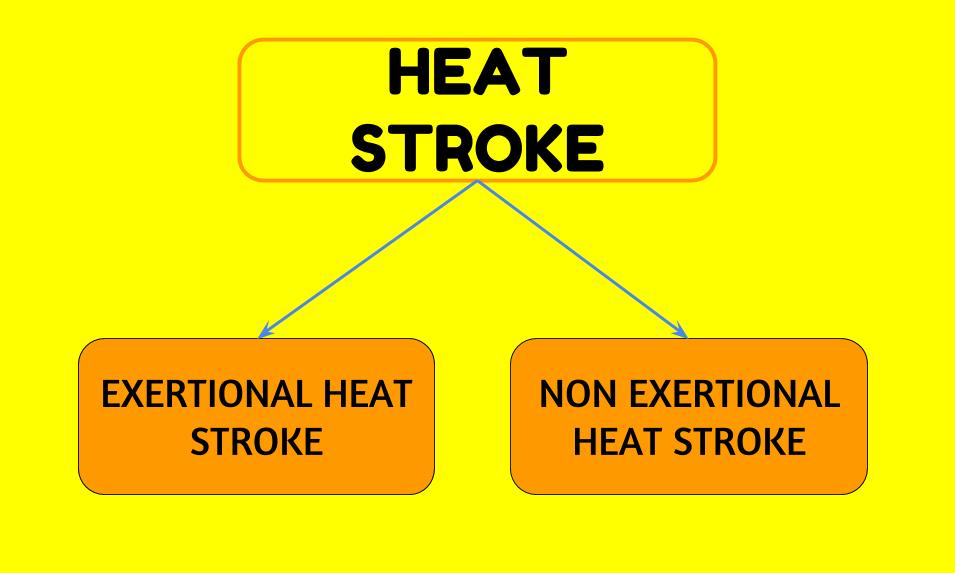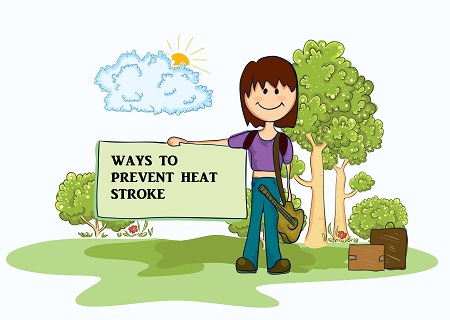If you are looking for ways to prevent heat stroke, then this article is for you.
Why? The heat!!
There has not been a great rise in temperature yet, but it appears it is affecting people a lot.
Just recently, I encountered a patient with a history of heart disease beginning to feel tired when he ventured out for a walk. He found the slight rise in temperature difficult to handle.
The temperature in India has always been high, and I am sure the upcoming months will see it peak like no other. Being exposed to such temperatures has it’s risks, and one such problem is heat stroke.
In fact, in 1998, the temperatures were so high in India that around 2600 people died in a span of 10 weeks from heat stroke.
Between 2004 to 2013, there was a 61% rise in heat strokes.
Here, we shall look at this condition in some detail, and discuss ways to prevent heat stroke from occurring.
Normal Body Temperature
Let’s start with the normal body temperature first.
Humans are warm blooded beings. Our normal body temperature is around 98.6 degrees Fahrenheit, or 37 degrees Celsius.
But there is something that you need to note about this.
This temperature is not what you feel when you hold someone’s hand or feel someone’s forehead. The normal  temperature refers to ‘core temperature’. This is temperature inside your body.
temperature refers to ‘core temperature’. This is temperature inside your body.
For example, you may measure the temperature by placing a thermometer under the armpit. The reading you get is usually 0.5 deg C lesser than the core temperature.
Core temperature is the temperature around the organs. The higher the core temperature is, the greater the damage to the organs.
Our body is able to maintain this temperature by striking a balance between the heat exposed to and the heat lost from the body. The mechanism is regulated by a part of the brain called the hypothalamus, also called the ‘thermostat’ of the body.
The way the body and the brain work with each other to regulate temperature is quite remarkable.
When the body temperature rises, the small ‘heat sensors’ located in the skin, muscle and spinal cord send signals to the thermostat in the brain.
This allows the body to get rid of the extra heat, which it does through conduction, convection and radiation (remember physics??). Evaporation of sweat is another way of cooling the body.
The best way to measure the core temperature is to place a thermometer in the rectum (through the anus). But I don’t think you want to be doing that!! Oral cavity temperature is accurate enough!
What Is Heat Stroke?
Heat stroke is a condition where the core temperature of the body rises above 41.1 deg C (or 106 deg F). It is the most severe form of heat exposure related illness and can be fatal.
There are 2 types of heat stroke, as described in the image below.

Non exertional heat stroke (NEHS) occurs in heat waves and is common in countries where this is rampant (like the Middle East). It tends to affect older individuals and children.
In NEHS, the body is unable to get rid of extra heat.
Exertional heat stroke (EHS) is usually seen in athletes and similar young, healthy individuals. Due to excessive activity, their body overheats and the temperature cross 41.1 deg F.
Often, EHS occurs because of associated features such as dehydration, tiredness and infection. Certain medication can also increase the risk of EHS. While the body is able to get rid of some of the extra heat, the quantity of heat already generated is too much for the body to handle.
What Are The Symptoms Of Heat Stroke?
Depending on the cause of heat stroke, symptoms may vary. Below are the symptoms of heat stroke.
1. Headache – Usually throbbing in nature
2. Dry skin and lack of sweating despite the heat (called anhidrosis). The skin can become red.
3. Dizziness or light headedness
4. Nausea and vomiting. Diarrhoea may occur
5. Increased heart beat
6. Rapid and shallow breathing
7. Confusion
8. Seizures
9. Loss of consciousness
Who Is At Risk Of A Heat Stroke?
As I have mentioned previously, heat stroke can be seen in athletes and those involved in sporting activities. This is because the body can overheat.
However, elderly patients, children, infants and those with a long term illness are at a risk as well.
To put it in simple terms, heat stroke occurs because of one of the following reasons –
- Excessive heat production in the body
- Retention of heat in the body and poor loss of heat
- Reduced ability of the body to get used to surrounding temperature (acclimatization failure)
There are a number of reasons why this occurs, but I will not go into too much details regarding this here.
A large part of why heat stroke also occurs is due to a factor called ‘heat index’. The heat index is a measure of how hot your body feels in the presence of elevated atmospheric temperatures and relative humidity.
When the relative humidity is above 60%, the sweating mechanism of the body is impaired. This makes cooling of the body a problem. The body overheats and heat stroke occurs.
In other words, if you are out in the heat and your sweat a lot, its good. Dry heat that burns is bad.
Individuals who consume a large amount of alcohol are at risk. Certain medications such as beta blockers and diuretics increase the risk of heat stroke.
If you feel you are at risk, you must ensure you take the right steps to prevent heat stroke.
Investigating Heat Stroke
I will not delve too much into this as it is the responsibility of the treating physician to do the tests.
However, if you are admitted with heat stroke, you should know that you will undergo certain blood investigations to determine the salt and water content of the body. Liver function tests, tests to assess muscle breakdown and an ECG will be performed.
Blood sugar levels and a chest x-ray may be done as well.
Heat Stroke Treatment
In the medical world, heat stroke is considered a medical emergency. This is because if it is untreated, it can be fatal.
Here are some important things you need to know about heat stroke treatment.
Firstly, get out of the sun!
The first step in treatment is to reduce the body temperature. This is done in a controlled manner using cold cloths and ice packs.
Intravenous fluids may be needed to re-hydrate the patient. These can be obtained if you visit a hospital or local clinic.
First Aid For Heat Stroke
If someone you are with has suffered a heat stroke, here is what you can do as a first aid measure.

Share this Image On Your Site – Copy The Code Below!
1. Move the affected person to a cooler area. Doing so will reduce their exposure to the hot environment.
2. Remove any clothing they are wearing, while ensuring their decency. Call for help immediately.
3. Wet a sheet or towel and cover them up with it. If you do not have one, make them sit or lie down under a fan or in an air conditioned cool room.
4. Pour water over them gradually to bring down their body temperature slowly.
5. Once you feel their temperature has come to normal, remove the wet clothing and replace it with dry clothing.
6. If possible, monitor their temperature, heart rate and blood pressure.
7. If the body temperature starts to rise again, repeat the above processes.
Ways To Prevent Heat Stroke

This is the important part that you must know and be aware of.
When venturing out into hot climate, wear light colored clothes. These can ward off heat and prevent the body from overheating.
Make sure you use a good quality sunscreen. One which has a Sun Protection Factor of 30 or more is advisable.
Carry a water bottle with you at all times. Keep sipping this water to keep yourself hydrated. This will help prevent heat stroke.
You may require 2 to 3 liters of water a day. You could replace a glass or 2 with fruit juice or re-hydration solutions.
If you are planning an exercise routine or wish to play outdoor sports, keep yourself hydrated. If you feel exhausted, take a break. Do not over-exert yourself if it is not necessary.
A good way to know if you are well hydrated or not is the color of your urine. If you urine is dark in color, it indicates low water content in the body.
Like I tell most of my patients – the water you drink and the urine you pass must be the same color.
Avoid caffeinated drinks and alcohol on hot days. These can increase the urine output and lead to dehydration.
Avoiding dehydration is a primary step to prevent heat stroke.
In your own home, use an air cooler or keep the fan on to maintain a pleasant ambient temperature. You may want to use the air conditioning unit from time to time.
Here’s a book form of this article for you to read! (I’m trying out new things)
Closing Remarks
Heat stroke can be deadly. Make sure you take the right steps to prevent heat stroke and make sure you stay cool this summer!
- CT Coronary Calcium Score: A Guide for Patients - January 7, 2024
- Gastric Antral Vascular Ectasia (GAVE) – Causes, Diagnosis, and Treatment - August 5, 2023
- Understanding Xanthelasma: Causes, Symptoms, and Treatment Options - June 28, 2023


DEAR DR VIVEK,
HEAT STROKE ARTICLE WAS REALLY VERY INFORMATIVE AND USEFUL SPECIALLY DURING THIS PEAK SEASON OF SUMMER SPECIALLY LOT OF FLUIDS AND JUICES SHOULD BE CONSUMED AND THE URINE COLOURATION IDENTIFICATION WAS VERY HELPFUL.
ALL IN ALL A VERY USEFUL ARTICLE MUST BE READ BY ALL SPECIALLY WHO WORK OUTDOOR ON SALES WORK.
REGARDS
S M PAI
Thank you for your comment Sir!